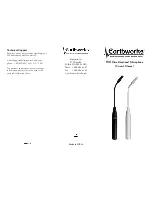
9
Operations
Auto-Noise Squelch Feature
Squelch circuits analyze Radio Frequency (RF) signal strength. When a wireless system is used in a noisy RF environment, conventional ciruits may
"open" unexpectedly, sending loud bursts of noise through the reciever when the transmitter's signal is weak or turned off. The VHF-3300 uses a noise
squelch circuit that analyzes signal quality with the signal strength. When the transmitter signal is strong, the system's noise level is low and the reciever
sends audio through. When the transmitter signal is weak or absent, the system's noise level is high and squelch circuit will mute the receiver. This
virtually eliminates the possibility of annoying bursts of noise coming through your receiver.
Receiver Volume Adjustment
The volume controls on the front panel of the VHF-3300 receiver can be adjusted to set the wireless system output levels as you desire. After making
any musical balancing adjustments, adjust the receiver volume control until the output reaches the desired level. Rotate the volume control clockwise to
increase output. Rotate it counterclockwise to decrease output.
Operating the System
1. Press the receiver POWER switch with the VOLUME CONTROLS turned down. The LED next to the POWER button on the receiver will glow RED.
2. Switch the microphone's power button to ON. During normal operation, the RF signal LED for each mic will light GREEN.
3. Talk or sing into the microphones while gradually adjusting the receiver VOLUME controls until you reach the desired output level.
Tips for Achieving Optimum Performance
--
It can be difficult to adjust VOLUME on the VHF-3300 and your sound system without creating feedback while standing so close to the receiver. It is
recommended to have one person test the mics from a distance while another increases the VOLUME levels for a better monitoring of your sound.
-- Place the receiver at least 3 feet (or 1 meter) above the ground and away from concrete walls or metal surfaces to prevent any reflections. The
microphone should also be at least 3 feet away from the receiver's antenna.
-- If using multiple wireless systems, maintain a distance of at least 10 feet (3 meters) between each.
-- Maintain a line-of-sight between the microphone and receiver antennas, if possible.
-- Avoid placing the receiver near computers or other RF generating equipment.
-- Avoid placing the reciever at the bottom of an equipment rack.
-- Extend telescopic antennas completely and as far apart from each other as possible. They can rotate in opposing directions to facilitate this.
-- Position the microphone 1" to 1.5" from the mouth or as close as practical to the desired sound source.
-- Move the mic closer to your mouth for extra bass response.
--
Use only one microphone per person or sound source.
-- Place microphones far from sound-reflecting surfaces.
-- Add a windscreen when using the microphone outdoors, for close-up speech, or vocals.
-- Avoid excessive handling to minimize mechanical noise.





























